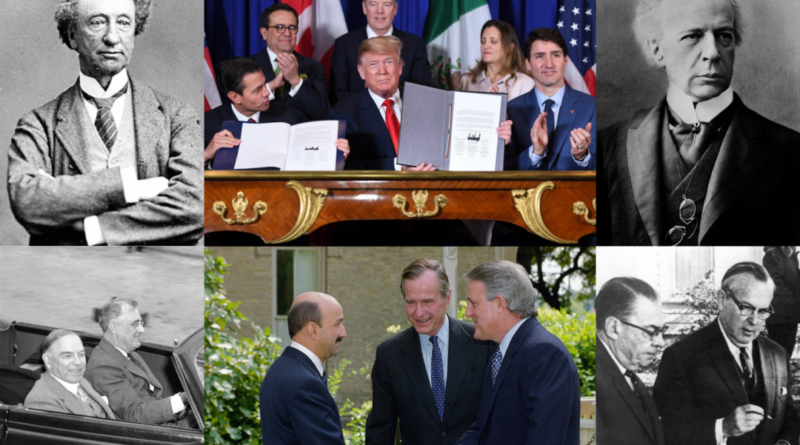The Rollercoaster of Canada-US Trade: A Look Back at 160 Years
A pivotal element of Sir John A. Macdonald’s vision for the nation he significantly contributed to establishing was a robustly protectionist trade policy, aimed at nurturing the growth of the young country’s burgeoning industrial sector in the face of American industrial dominance.
The pro-free trade Liberals of that era opposed Macdonald’s Conservative National Policy, which imposed steep tariffs on imported goods into Canada. Nevertheless, over the ensuing century and a half, the stances of the two sides evolved and eventually converged, leading to a broad acceptance of free trade or minimized trade barriers with the United States as an integral part of Canadian life.
A moment of peak discord over this issue occurred during the 1988 federal election, where Brian Mulroney’s Progressive Conservatives advocated for a free trade deal with the United States, while John Turner’s Liberals vehemently opposed it.
With a current “America-first” president in the White House reconsidering the status quo of free trade with Canada, it’s worth exploring the roller-coaster history of trade deals between Canada and its southern neighbor.
Pre-Confederation
Prior to Confederation in 1867, the provinces that would eventually form Canada enjoyed a decade of a free-trade treaty, known as “reciprocity,” with the United States.
At that time, British North America encompassed New Brunswick, Nova Scotia, Prince Edward Island, the colony of Newfoundland, and the province of Canada (now Ontario and Quebec).
However, in 1866, the United States scrapped the treaty due in part to the province of Canada imposing the protectionist Cayley-Galt tariffs of 1858–59 on manufactured goods in a bid to boost local manufacturing.
Some Americans perceived that Canada was the prime beneficiary of the reciprocity pact and, combined with protectionist sentiments in the U.S., the deal was negated.
1867: Formation of Confederation
The imperative to fortify the domestic market and apprehensions that the more economically robust United States could potentially dominate or even annex British North America drove the momentum for Confederation, among other motivations.
On July 1, 1867, four British colonies—Nova Scotia, New Brunswick, Ontario, and Quebec—united to establish the Dominion of Canada as a self-governing entity within the British Empire, with Sir John A. Macdonald serving as its inaugural prime minister from 1867 to 1873.

Sir John A. Macdonald, Canada’s first prime minister, in an undated photo. NFB/National Archives of Canada
1879: Macdonald’s National Policy
During his second term in office, from 1878 to 1891, Macdonald’s Conservative Party introduced the National Policy in its initial year, a protectionist strategy focused on cultivating the national economy of the newly formed nation situated north of an industrial giant.
The policy entailed imposing hefty tariffs on imported goods to shield Canadian manufacturers from U.S. competition. It also prioritized population augmentation through immigration and the enhancement of infrastructure, including the construction of a transcontinental railway.
1896-1911: Wilfrid Laurier’s Free-Trade Ambition
Upon Wilfrid Laurier assuming power as Prime Minister in 1896, the Liberal Party, although not ideologically aligned with protectionism as favored by the Conservatives, retained the National Policy. Laurier’s administration subsequently brokered a free-trade accord with the United States, sanctioned by the U.S. Congress in 1911. Despite holding a parliamentary majority, Laurier opted for an election later that year, with free trade being a central focal point.

Prime Minister Wilfrid Laurier. National Archives of Canada/The Canadian Press
In that election, Laurier was defeated by the Conservatives amidst growing apprehensions that free trade could grant America economic control over Canada, weaken the British tie, and potentially lead to annexation. Consequently, the 1911 free-trade agreement was never enforced.
1930: Great Depression Tariffs
Amid the Great Depression of the 1930s, trade ties between Canada and the U.S. hit a nadir. The U.S. unveiled the Tariff Act of 1930, more commonly known as the Smoot-Hawley Tariff Act, which heightened tariffs on over 20,000 imported goods to shield the economy. U.S. imports and exports dramatically plummeted, exacerbating the repercussions of the Great Depression.
Some scholars assert that these protectionist policies instigated a wave of counter-measures from trading partners, including Canada, which also raised its tariffs in 1930.
1935-1938: Tariff Reduction
Following a slump in Canada-U.S. trade throughout the Great Depression, the two nations struck a milestone agreement in 1935 that revitalized cross-border trade for the first time since Confederation.
The Canada-U.S. Reciprocal Trade Agreement, championed by Prime Minister William Lyon Mackenzie King and U.S. President Franklin Roosevelt, slashed tariffs and alleviated chronic trade barriers, albeit not to the extent of the 1854 Reciprocity Treaty.
A subsequent agreement in 1938 further trimmed tariffs from the prior deal, enabling smoother imports into Canada while facilitating the export of goods like lumber, cattle, fish, dairy products, potatoes, and machinery.
In the ensuing World War II years and the subsequent Cold War era, there was heightened U.S. interest in Canada’s natural resources to fortify national security.

U.S. President Franklin Roosevelt drives with Canada’s Prime Minister W. L. MacKenzie King to the Little White House, his home in Warm Springs, Georgia, on April 23, 1940. George Skadding/AP Photo
1948: GATT Agreement
In 1948, Prime Minister Mackenzie King ceased free-trade discussions with the United States, with some scholars attributing this decision to deep-rooted Canadian apprehensions that enhanced Canada-U.S. economic ties could lead to American annexation.
Source link
- Sen. Coons: DOGE Has ‘Infiltrated’ the Private Data of All Americans
- Democrats Delay Critical Vote on Trump’s FBI Nominee Patel





